Sunday 31 August, 2014, 12:28 - Spectrum Management
Posted by Administrator
Yet another challenge to the seemingly overinflated forecast demand for IMT spectrum has been raised. This time, a paper entitled, 'Overestimating Wireless Demand: Policy and Investment Implications of Upward Bias in Mobile Data Forecasts' which has been written by Aalok Mehta of the University of Southern California and J. Armand Musey of Goldin Associates. Posted by Administrator
 Rather than do the maths on what their paper says, Wireless Waffle thought that it might be better to take a different approach and try and estimate how much spectrum may be needed in the far future, say in the year 2525. How much data could each person possibly consume? If it is assumed that each person lives in a totally immersive environment where there visual, audio and maybe even sensory experience is completely connected (a bit like a man-made version of The Matrix!) the question is how much data would this take?
Rather than do the maths on what their paper says, Wireless Waffle thought that it might be better to take a different approach and try and estimate how much spectrum may be needed in the far future, say in the year 2525. How much data could each person possibly consume? If it is assumed that each person lives in a totally immersive environment where there visual, audio and maybe even sensory experience is completely connected (a bit like a man-made version of The Matrix!) the question is how much data would this take? There are three things to consider:
- Firstly how much data is needed for such an immersive experience;
- Secondly, how much progress will have been made on the various audio and video codecs which squish the raw data into a more manageable form; and
- How spectrally efficient will the mobile technology be?
Video is currently the main bandwidth hog and whilst touch, feel and smell may turn out to be equally hungry for connectivity, let's focus on the video requirements first. If it is assumed that 3D video using ultra-high definition is required, today this would require a connection of 40 Mbps or faster. With improvements in coding technology, this could easily drop to 10 Mbps. If audio and other sensory data (including any personal machine-to-machine communications detecting, for example, heartbeat, ambient temperature and so on) doubles this, then a working assumption that a constant 20 Mbps of connectivity would allow a fully immersive experience would seem about right.
Finally we need to think about spectrum efficiency - how much spectrum would be needed to deliver this 20 Mbps. Current technologies such as LTE can deliver many bits per second per Hz of spectrum but performance becomes worse the futher away from the centre of a cell a user is. The ITU's model uses values of up to 5 bits per second per Hz in a 2020 timeframe, though other forecasts show values ranging from 2 to 15. By 2525, it ought to be possible to at least achieve the 5 bits per second per Hz value that the ITU forecasts is feasible by 2020, even as an average across a cell, and even those at the edge of coverage. This means that (whilst awake and living in the immersive environment) our mobile subscriber of 2525 would require around 4 MHz of spectrum dedicated to their sole usage.
How much spectrum is needed is therefore simply dictated by how many simultaneous users there are in each cell. Looking at this from a different direction, with around 1 GHz of mobile spectrum (not that different from the amount available today), 250 users could be supported in each cell. This seems perfectly realistic. Of course this amount of data would not be required by anyone who is asleep, and those at home or in an office could surely connect to the WiFi of the future and offload their data to an alternative service so 250 users per cell does not seem unreasonable.
So... even in a futuristic world in which everyone is immersed in a fully interactive environment for every waking hour, given developments in technology, 1000 MHz of spectrum dedicated to mobile networks seems sufficient. This result ties in with an interesting result posited by the Australian spectrum regulator ACMA in its report 'Towards 2020 - Future spectrum requirements for mobile broadband' (Figure 4.3) which indicates that spectrum demand may decrease in the future as the spectrum efficiency of newer technologies and improved coding techniques outpace the exponential growth in demand for data.
It therefore seems possible that we are going through a period in which spectrum demand for mobile broadband is at its peak as we phase out older mobile technologies and bring in the new and that in the long-term future, the amount of spectrum already available today will be enough to meet requirements. With this (albeit rather simplistic) analysis, we can now close the door on all the debate over spectrum for mobile services and instead focus on something more interesting...
add comment
( 948 views )
| permalink
| 



 ( 2.8 / 1148 )
( 2.8 / 1148 )




 ( 2.8 / 1148 )
( 2.8 / 1148 )
Wednesday 9 July, 2014, 08:57 - Spectrum Management
Posted by Administrator
According to an article in DigitalSpy (and several other sources) UK mobile operator EE have announced that during the recent Glastonbury Festival, 0.74 TeraBytes (TB) of data was uploaded and 2.49 TB of data was downloaded (a total of 3.23 TB). EE built a special network at the site as part of its role as the sponsor. However it would be reasonable to assume that the other 3 mobile operators in the UK also carried traffic and despite them not having bespoke networks, designed to cover the event, let's give them the benefit of the doubt and assume that they carried as much traffic as EE. Thus, the total traffic from the event would be 12.9 TB.Posted by Administrator
It is interesting to compare this level of traffic with that which is predicted by the ITU spectrum demand forecast model that Wireless Waffle has discussed several times in the past. First some facts and figures about the festival:
- The 2014 Glastonbury festival ran from 25 - 29 June inclusive - 5 days in total.
- The area of the site is approximately 900 acres, which is 3.6 square km.
- Around 135,000 people attended the festival.
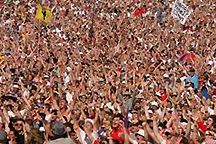 We can therefore calculate some traffic figures and compare these to the ITU's forecasts. First of all, the easy one: 135,000 people in an area of 3.6 square kilometres equates to 37,500 people per square kilometre. The ITU's model shows up to 222,333 people per square kilometre in the densest (albeit urban) areas, but it would be hard to imagine an area more densely populated than that surrounding the festival, even in Central London.
We can therefore calculate some traffic figures and compare these to the ITU's forecasts. First of all, the easy one: 135,000 people in an area of 3.6 square kilometres equates to 37,500 people per square kilometre. The ITU's model shows up to 222,333 people per square kilometre in the densest (albeit urban) areas, but it would be hard to imagine an area more densely populated than that surrounding the festival, even in Central London. There was 12.9 TeraBytes of data traffic over the 5 day event, the equivalent of 78 TeraBytes per month if the same level of traffic was to continue over a whole month. This equates to 21.7 TB per month per square kilometre. For a densely populated (urban) area, the ITU's forecasts show 30 to 100 PetaBytes per month per square kilometre, 1,400 to 4,700 times more than was consumed by revellers at Glastonbury.
Finally, if 78 TB of data was generated by 135 000 people, this equates to 578 MegaBytes per person per month. Compare this with the 212 GigaBytes per person per month preducted by the ITU, and we find a that the ITU's values are 366 times larger.
 So the ITU's traffic forecasts for 2020 show traffic density over 1,500 times greater than that which was generated at Glastonbury, with individual (per person) traffic that is 366 times larger. Even given the likely growth in data between 2014 and 2020 (which the ITU's highest forecasts indicate a growth of a factor of 14 times), the ITU's figures remain far in excess of any reality - at least any reality that exists on planet Earth. Just what the value of a set of forecasts that might be valid on Kepler 22b is, is anyone's guess. Perhaps that's where the ITU spends its summer vacation?
So the ITU's traffic forecasts for 2020 show traffic density over 1,500 times greater than that which was generated at Glastonbury, with individual (per person) traffic that is 366 times larger. Even given the likely growth in data between 2014 and 2020 (which the ITU's highest forecasts indicate a growth of a factor of 14 times), the ITU's figures remain far in excess of any reality - at least any reality that exists on planet Earth. Just what the value of a set of forecasts that might be valid on Kepler 22b is, is anyone's guess. Perhaps that's where the ITU spends its summer vacation?Wednesday 11 June, 2014, 09:00 - Spectrum Management
Posted by Administrator
You would have thought that those designing systems that use the radio spectrum would check that the frequencies they planned to use would not cause interference to other systems and equally importantly that they would not suffer interference from other users. Such basic compatibility checks are critical to ensure that different communication systems can inter-operate successfully. So it is a bit of a surprise to find that the designers of the Eurobalise, a technology that forms part of the European Rail Traffic Management System and whose purpose is to assist in the control of train movements (to control their movement and help them know where they are) has chosen a frequency which fails these simple safeguards.Posted by Administrator

Where they have gone wrong is to use a frequency for transferring information between the Eurobalise and the train that is in a European broadcast band!
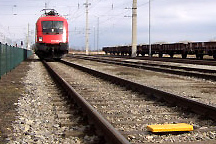 The Eurobalise uplink operates on a centre frequency of 4234 kHz, with a frequency deviation of +/- 282 kHz. This means that a logic '1' is sent on a frequency of 4516 kHz and a logic '0' is sent on a frequency of 3952 kHz (source: Mermec Eurobalise specification). Interfering signals on, or near, frequencies of 3952 or 4516 kHz would cause the most trouble, but as the Balise's receiver is listening across the whole range 3952 to 4516 kHz, any transmission in this range would cause a problem. The (European) 75 metre broadcast band runs from 3950 to 4000 kHz. Any broadcasts in the 75 meter band could therefore cause a problem to nearby trains, but those on frequencies from approximately 3950 to 3955 kHz will have the greatest potential to interfere with the Balise's operation.
The Eurobalise uplink operates on a centre frequency of 4234 kHz, with a frequency deviation of +/- 282 kHz. This means that a logic '1' is sent on a frequency of 4516 kHz and a logic '0' is sent on a frequency of 3952 kHz (source: Mermec Eurobalise specification). Interfering signals on, or near, frequencies of 3952 or 4516 kHz would cause the most trouble, but as the Balise's receiver is listening across the whole range 3952 to 4516 kHz, any transmission in this range would cause a problem. The (European) 75 metre broadcast band runs from 3950 to 4000 kHz. Any broadcasts in the 75 meter band could therefore cause a problem to nearby trains, but those on frequencies from approximately 3950 to 3955 kHz will have the greatest potential to interfere with the Balise's operation. Do any such transmissions exist? According to short-wave.info, the BBC and Korean broadcaster KBC use a frequency of 3955 kHz on a daily basis, from the BBC's transmitter at Woofferton, Shropshire. If you click on the link (which will take you to Google maps) you will notice that running alongside the village of Woofferton is a grey line - a railway!
But surely fears of interference are unfounded and just another example of scare tactics by spectrum managers bent on safeguarding their highly paid jobs. Sadly not... It appears that the transmissions from Woofferton have been disrupting trains between Leominster and Ludlow! According to the article in the Hereford Times, Network Rail, the organisation responsible for operating the rail infrastructure in the UK, claim:
while the interference does not pose a risk to the safe operation of the railway, it has been stopping trains en-route.
Oops!
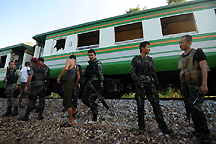 The only other high power transmitter in this band in Europe is at Issoudun in central France. A quick check of Google maps shows that there are no train tracks in the immediate vicinity. There is a transmitter in Kall-Krekel in north west Germany which also uses frequencies in the 75 metre broadcasting band that could also cause interference to Eurobalises, but that transmitter uses much lower power than those at Woofferton or Issoudun.
The only other high power transmitter in this band in Europe is at Issoudun in central France. A quick check of Google maps shows that there are no train tracks in the immediate vicinity. There is a transmitter in Kall-Krekel in north west Germany which also uses frequencies in the 75 metre broadcasting band that could also cause interference to Eurobalises, but that transmitter uses much lower power than those at Woofferton or Issoudun.Maybe, given that there is only one potential location where the choice of frequency, and proximity to a broadcast transmitter, could be a problem, the designers did do their homework after all and decided that it was alright for occasional problems to arise. Maybe. Then again, the other frequencies used by the Eurobalise include a military band and the middle of the 27 MHz Citizens Band!
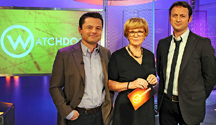 Last night’s BBC Watchdog programme discussed the issue of the apparently poor WiFi connectivity available on a number of inter-city train routes across the UK. The programme conducted a survey of the paid-for WiFi service of three long-distance train operators. They measured the percentage of the journey for which a connection was available, and the time it took to download a short file. The average results, together with the current tariffs for WiFi on the three train companies surveyed are shown below.
Last night’s BBC Watchdog programme discussed the issue of the apparently poor WiFi connectivity available on a number of inter-city train routes across the UK. The programme conducted a survey of the paid-for WiFi service of three long-distance train operators. They measured the percentage of the journey for which a connection was available, and the time it took to download a short file. The average results, together with the current tariffs for WiFi on the three train companies surveyed are shown below.| Train Operator | Connection Available | Time To Download A File | Price |
|---|---|---|---|
| Cross-Country | 96.7% | 39 seconds | £2 for 1 hour, £8 for 24 hours |
| East Coast | 79.4% | 13 seconds | £4.95 for 1 hour, £9.95 for 24 hours |
| Virgin Trains | 82.2% | 112 seconds | £4 for 1 hour, £8 for 24 hours |
WiFi services on trains are provided by using antennas on the roof of the trains to connect to mobile networks. These mobile internet connections are then shared amongst all the WiFi users on a train. Companies such as Icomera and Nomad Digital provide boxes that enable multiple mobile internet connections to be combined together to increase the speed of the connection as a single 3G or 4G connection is not going to cut it when shared between multiple WiFi users.
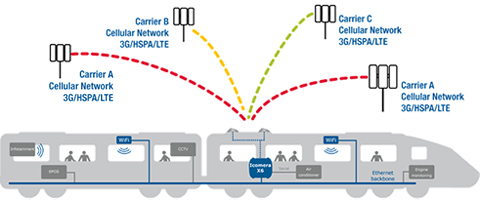
In the programme, self-proclaimed IT Guru Adrian Mars then goes on to explain that the problem with the East Coast and Virgin services is that they make use of the signal from just one mobile operator and share that amongst all the WiFi users on the train, whereas Cross-Country use connections from multiple operators. This would explain why the time for which a connection was available on Cross-Country’s WiFi service was so much higher than on the other two, as they can make use of the overlapping coverage provided by multiple operators.
 It is also true to say that many of the UK’s inter-city train routes pass through very sparsely populated areas, as well as tunnels and deep cuttings, where there is unlikely to be much in the way of a mobile signal. Given the different routes taken by Cross-Country, East Coast and Virgin Trains it is therefore unfair to directly compare them as each route will have a different proportion of these hard-to-get-at areas. 3G and 4G mobile networks also don’t work as well at high speed and (usually) trains travel at speeds that are fast enough to begin to affect performance.
It is also true to say that many of the UK’s inter-city train routes pass through very sparsely populated areas, as well as tunnels and deep cuttings, where there is unlikely to be much in the way of a mobile signal. Given the different routes taken by Cross-Country, East Coast and Virgin Trains it is therefore unfair to directly compare them as each route will have a different proportion of these hard-to-get-at areas. 3G and 4G mobile networks also don’t work as well at high speed and (usually) trains travel at speeds that are fast enough to begin to affect performance.Where the Watchdog’s IT guru did go astray was to suggest that it might be better for train passengers to rely on the connection to their own mobile phone for internet rather than the on-train WiFi. Why is this wrong? There are two main reasons. Firstly, the antennas used by the on-train WiFi systems are mounted on the train roof, whereas your phone will be lower down, inside the carriage. A previous Wireless Waffle article highlighted the need to get high to improve reception and the signal on the roof of the train will be bigger than that inside by dint of this fact alone.
But there is a much bigger problem… trains are typically constructed of metal. Some, including Virgin Trains’ Pendolino trains, have metallised windows. Passengers are thus enclosed in a Faraday cage which will do a grand job of stopping any signals on the outside of the carriages from making their way into the carriages. According to a paper written by consultants Mott MacDonald for Ofcom:
In modern trains the attenaution[sic] can be up to -30dB.
This means that of the signal presented to the outside of the carriage, only one thousandth of it makes it inside the carriage. Add this immense loss to the difference in height between the roof-mounted antenna and you sat in the carriage and it becomes apparent why using your own phone is highly unlikely to yield a better connection than that available through the on-train WiFi.
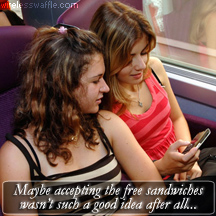 The Watchdog team suggested that due to the poor quality of the on-board WiFi it should be offered for free instead of making passengers pay. Many fare-paying train passengers would no doubt express a lot of sympathy with this suggestion. The cost to the rail companies of doing this is not trivial. East Coast, it was claimed, are upgrading their on-board WiFi to the tune of £2 million which compared to the paltry £7m profit they made in 2012/13 is quite a bite. But given the choice of free sandwiches (whose quality is as notoriously dubious as that of the WiFi connection) or free WiFi, most would surely prefer to enhance their digital diet instead of their gastronomic girth.
The Watchdog team suggested that due to the poor quality of the on-board WiFi it should be offered for free instead of making passengers pay. Many fare-paying train passengers would no doubt express a lot of sympathy with this suggestion. The cost to the rail companies of doing this is not trivial. East Coast, it was claimed, are upgrading their on-board WiFi to the tune of £2 million which compared to the paltry £7m profit they made in 2012/13 is quite a bite. But given the choice of free sandwiches (whose quality is as notoriously dubious as that of the WiFi connection) or free WiFi, most would surely prefer to enhance their digital diet instead of their gastronomic girth. 
